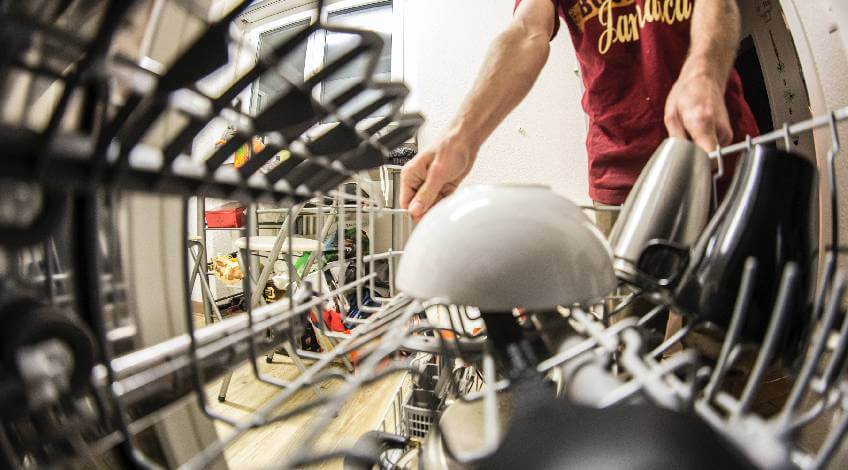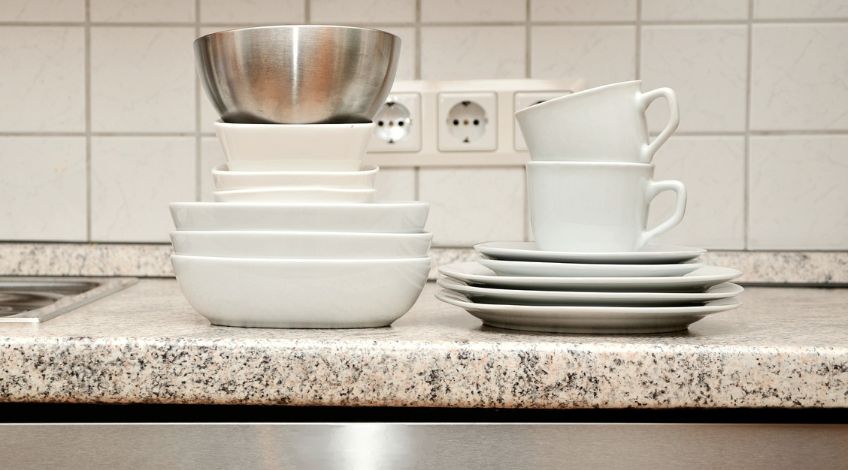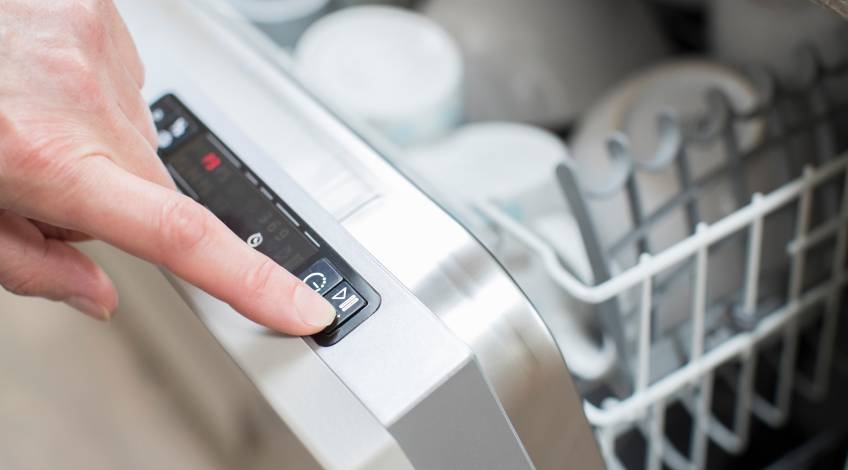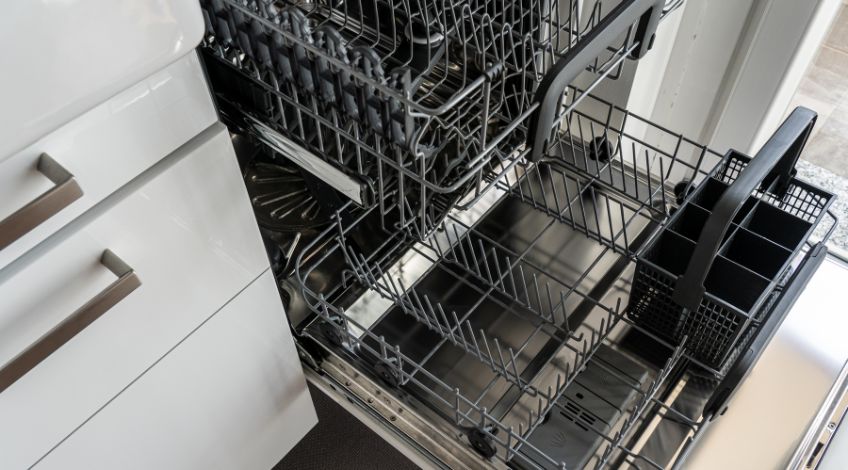
LG Dishwasher Not Drying? (here’s why & what to do)
Cleaning dishes is only half the story when it comes to dishwashers. If your LG dishwasher isn’t drying dishes properly, it’s not working right. But before you contact the manufacturer or get a technician to investigate, there could be a simple explanation.
To find out more, keep reading, because in this article we look at all of the reasons why your LG dishwasher might not be drying your dishes and offer solutions.
Why Is The LG Dishwasher Not Drying?
There are several reasons why a LG dishwasher isn’t drying the dishes which include;
| Probable Cause | Solution |
|---|---|
| Incorrectly stacked dishes | Always stack the dishes in a way conducive to proper drying |
| Unloading the dishwasher incorrectly | Always unload the dishwasher from the bottom up |
| No rinse aid | Ensure the rinse aid dispenser is topped up |
| Heated dry function not selected | Always ensure the heated dry function is selected before starting a wash cycle |
| Defective heating element | Inspect and replace the heating element if necessary |
| Clogged air vent | Clear any obstructions blocking the air vent |
| Defective thermostat | Check and replace the thermostat if necessary |
| Defective fan | Check and replace the fan if necessary |
Incorrectly Stacked Dishes

The most common reason why any dishwasher fails to dry dishes is overloading or incorrectly stacking dishes. Forcing too many items in each rack can not only prevent them from cleaning properly, but also restrict the airflow leaving the dishes wet.
Then there’s the problem of placing the wrong items in the wrong place in the dishwasher. You should always load your dishwasher’s racks in the following way;
Top Rack
Glasses, cups and bowls should be placed upside down so they don’t collect water.
Bottom Rack
Place dishes and plates facing inwards and ensure there is a gap between each one. This allows the hot air to flow around each one ensuring it dries properly.
Cutlery Basket
To prevent cutlery items from nesting, place knives, forks and spoons in alternate slots. This allows them to clean and dry better.
Plastic Items
Plastic items will not dry as well as dishes and glassware because plastic doesn’t retain heat as well as crockery and other glassware items.
If you have any dishwasher safe plastic items you should consider washing them in a separate load. Allowing them to dry at a slower rate than other items.
Unloading The Dishes Incorrectly

You should always unload the bottom rack first to prevent any moisture from the top rack dripping onto the dishes below. By unloading the bottom rack first, any moisture left in the dishes above will not be disturbed, keeping at least one rack of dishes dry.
No Rinse Aid
Not topping up the rinse aid dispenser is another common reason for dishes remaining wet in a LG dishwasher. Rinse aid is a drying agent that changes the shape of water drops allowing them to drop off dishes and glassware easily.
This leaves less moisture for the dryer function to remove, which leads to dryer dishes. You should top up the rinse aid dispenser before every use and fill it to the maximum fill level.
However, if you use dishwasher 3-in-1 tablets or pods, which contain rinse aid, there is no need to top up the dispenser in the dishwasher.
Heated Dry Function Not Selected

For your LG dishwasher to use the heated dry function, it has to be manually selected. Ensure you press the button for the heated dry cycle before starting the dishwasher.
This will ensure that the heating element and/or drying fans engage at the end of the wash and rinse cycles. If you have selected the heated dry function and you’re not satisfied with the level of drying, you should check the user manual as some models have additional options. These include;
Night Dry
This is the best option if you run your dishwasher at night. After the wash and rinse cycle have completed, the drying fans will operate through the night at intermittent periods. Leaving the dishes dry the following morning.
Sanitary Rinse
Selecting this function will get your dishes hotter and allow them to dry slowly. This improves overall drying.
Extra Dry
This function increases the temperature of the heated rinse cycle and has an extended drying cycle.
Defective Heating Element
The heating element is responsible for heating the water to wash the dishes in the dishwasher and provide the heat used during the drying cycle. If the heating element becomes defective, the dishes will not get washed or dried properly.
You can check whether the heating element is working properly using a multimeter and checking for continuity. However, if you’re not confident in your abilities, we recommend getting an expert to do this for you.
Clogged Air Vent

The hot air used to dry the dishes in your dishwasher has to pass through an air vent before being circulated throughout the dishwasher. If the air filter is clogged or blocked, the hot air cannot circulate and the dishes will not dry.
You will need to locate the air vent (which is typically located at the bottom left-hand side of the door) and remove any food particles or debris. You can then clean the vent thoroughly using a toothbrush or similar.
You should also remove the filter and give it a good clean under running water using a soft brush to remove any stuck on debris.
Defective Thermostat
The thermostat regulates the temperature of the water that washes the dishes and the hot air used to dry them. If you suspect the thermostat is defective, you can check it using a multimeter.
However as this involves dismantling the appliance we recommend getting an expert to do this for you. If it does prove to be defective, it will need to be replaced.
Defective Fan
If everything else appears to be working correctly, there’s a possibility that the fan itself has developed a fault. It might not be spinning properly or have become damaged in some way.
This is another task best left to an expert unless you are confident in your abilities.
Can I Fix My LG Dishwasher Myself?
As you can see from this article, in many cases you can fix the problem of a LG dishwasher not drying without calling on an expert. Many of the fixes are more about selecting the correct settings, placing dishes correctly and maintaining your appliance.
However, there are certain problems that may need some technical knowhow. We would always recommend working within your skill levels, many of these tasks can and should be carried out by you – But there are some that are probably a bit beyond your comfort zone.
SEE ALSO: LG Dishwasher Won’t Start But Has Power? Here’s why & what to do
Frequently Asked Questions
To get your LG dishwasher to dry the dishes it is necessary to ensure it has rinse aid. You should also select a high temperature setting and the extra dry option to get a better drying result.
At current prices, you can expect to pay anywhere between £30 to £50 for a replacement heating element for a LG dishwasher. You will then need to find someone to fit it which could cost far more.
Depending on the model of LG dishwasher you own and how often you use it, the rinse aid should be topped up after around 20 to 30 washes.
Also, follow us on Pinterest ...



